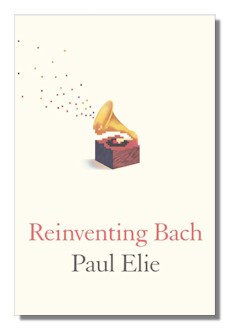
The Internet's Premier Classical Music Source
Related Links
-
Introduction
Acoustics
Ballet
Biographies
Chamber Music
Composers & Composition
Conducting
Criticism & Commentary
Discographies & CD Guides
Fiction
History
Humor
Illustrations & Photos
Instrumental
Lieder
Music Appreciation
Music Education
Music Industry
Music and the Mind
Opera
Orchestration
Reference Works
Scores
Thematic Indices
Theory & Analysis
Vocal Technique
Search Amazon
Recommended Links
Site News
 Book Review
Book Review
Reinventing Bach

Paul Elie
New York: Farrar, Straus and Giroux
498 pages
ISBN-10: 0374281076
ISBN-13: 978-0374281076 (alk. paper)
It would seem that Elie's title is a play on Bach's Two and Three Part Inventions. The Inventions were short themes which Bach wrote expressly to be worked out or added on to. Elie's main subject is an account of performers since Albert Schweitzer who have been particularly associated with the music of Johann Sebastian Bach, mostly by way of transformative recordings. Albert Schweitzer, Pablo Casals, Leopold Stokowski, Glenn Gould and Yo Yo Ma loom large in his account. Joshua Rifkin, John Eliot Gardner, and even the New Century Saxophone Quartet are among others he writes about. Sandwiched in between the performers, considered at various points in their careers, are accounts of Bach's life and work at various stages of his career. In this, Elie's approach somewhat resembles Gaines' Evening in the Palace of Reason, which intertwines stages of the lives of Bach and Frederick the Great. Like Gaines, Elie writes in a very readable style. A latecomer to Bach's music, but one who has more than made up for that, Elie often writes in the first person.
What Schweitzer did with Bach's music (in addition to writing a book about it) was to make an important early recording of Bach's Toccata and Fugue in D Minor. Casals, of course, is most associated with the Suites for Cello, a score of which he discovered at a very young age in a shop, at a time when nobody performed more than individual movements of these works. This happened in his childhood; his father had just acquired a three quarter size cello for him. Casals played the Suites in solitude for many years before playing them in public, and then recorded them, two at a time, in the late 1930's. He never recorded them again. Gould happened to record the Goldberg Variations twice, at the very beginning of the LP era and again at the very beginning of the CD era, just before he died. As is well known, he was very devoted to the recording process, including the splicing together of different parts of a long work, sometimes after many takes. It took him 31 takes to be satisfied with the aria which begins the Goldbergs. Stokowski made many orchestral transcriptions, including one of the Toccata and Fugue in D Minor, which was included in Disney's Fantasia and rendered as abstract colored patterns – a three part "reinvention," as it happened. Another reinvention is Peter Sellars production of Bach cantatas sung by the late lamented Lorraine Hunt Lieberson, partly in hospital garb as she was in her final illness.
There is considerable detail about the non-musical lives and concerns of these performer's: Schweitzer's life of Jesus and especially his medical work in Africa; Casals' exile and opposition to Franco's Spain, which went so far as his refusal to play in any country that recognized Franco's government – eventually relaxed when he decided to go to Marlboro; Stokowski's marital history and even Gould's affair with the wife of Lukas Foss. What Elie does not consider at all is the Bach-inspired music of the neoclassical composers such as Hindemith, Piston and others. To be sure that is a subject for another book.
Included at the end are sixty pages of notes, grouped by section rather than by page or item. More than citations, they refer to and discuss various sources and other matters excluded from the text. I have no objection to this kind of treatment, as I know from personal experience how tedious – and often disappointing – citation references can be.
I do have reservations about the overall organization of the book. There are six "Parts" and a "Postlude," which are not easily identifiable as to subject contents. Preferable would have been either a detailed table of contents identifying, for instance: Bach's early career before he went to Leipzig and, say, Schweitzer's musical career; or, better, separate chapters on the careers of each of the major figures, with the concluding chapter dealing with the many transformations of Bach in the digital era, as written. One very minor suggestion, in case of another edition – or even a later printing: the misspelling of Ton Koopman's name (printed as Tom in three places including the index) should be corrected – at least by an errata slip.
These reservations are minor. I learned a great many things I did not know by reading this book and I was struck by a number of images that Elie treats us to. Recommended.
Copyright © 2012, R. James Tobin



















